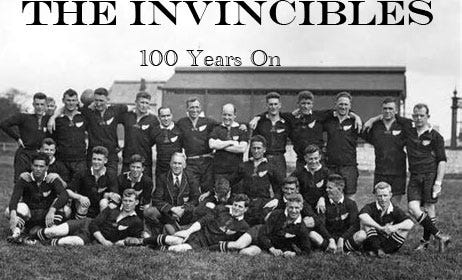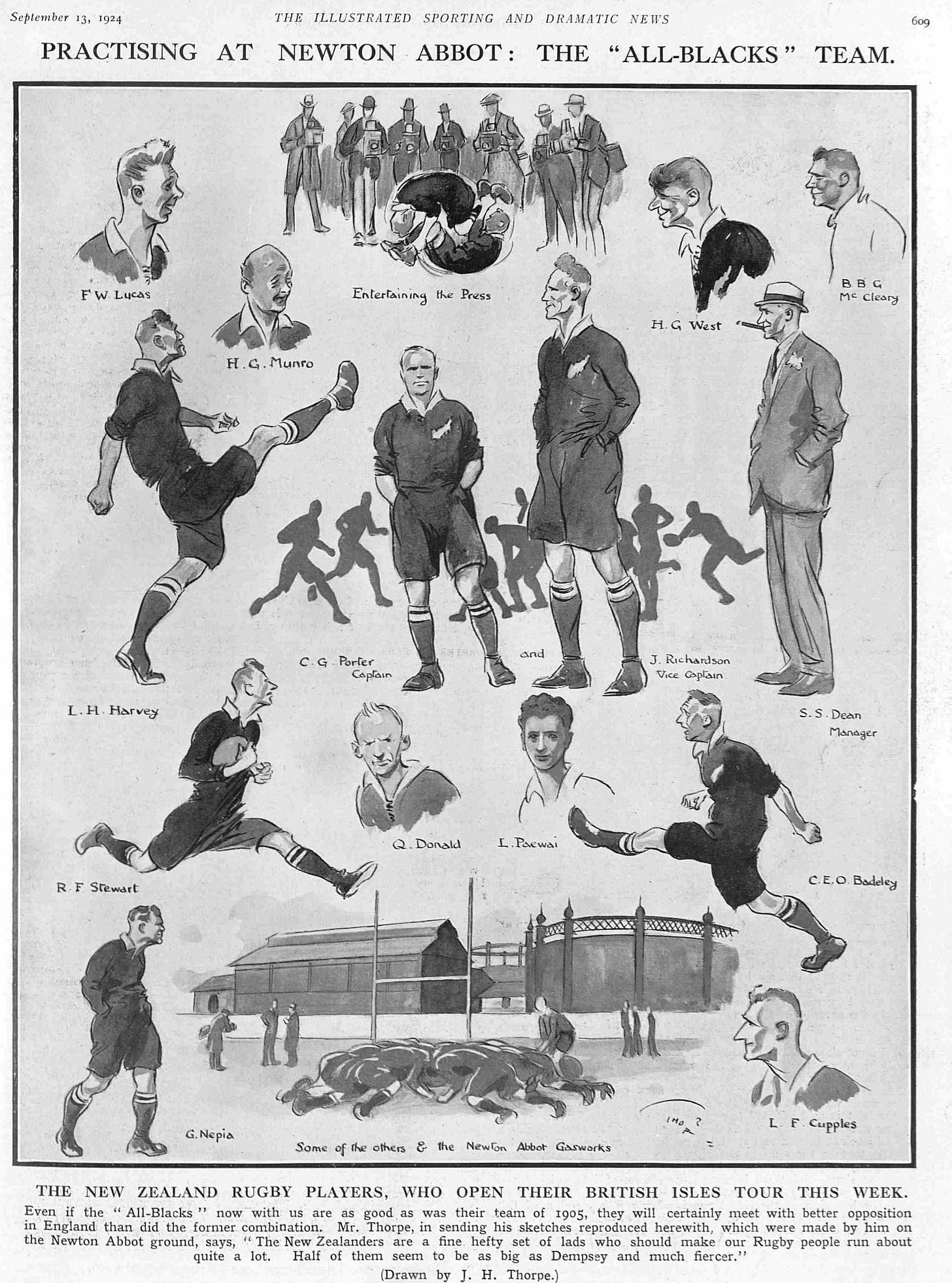Welsh rugby legend and the man who scored the try that beat the 1905-06 Originals, Dr E.T. Morgan, had his first look at the 1924-25 All Blacks in Gloucestershire and said no club side would beat them on their tour, and only a 'very fine' international side would hold them.
Those points were rammed home harder a day later when the All Blacks got their first taste of Welsh rugby, beating Swansea 39-3.
Morgan, who toured New Zealand in 1904 with the British side, said if anyone asked him where the real home of rugby football was, he would say New Zealand.
The New Zealanders are a proud race, and better judges of football do not exist.[1]
He immediately summed up Cliff Porter's play, saying he was the equal of Dave Gallaher - always on the ball, tackling like a demon while showing the handling skills of a three-quarter. Notably, Morgan said Porter committed no instances of obstruction.
After two hours travelling from Newport to arrive at 1 pm, before the game, Morgan was even more impressed after the hefty loss the All Blacks inflicted on Swansea.
We saw a team of men physically superior, much faster, and much more finished in their movements, individually and collectively, over run a stubborn and plucky opposition.[2]
He rated the inter-passing between forwards and backs as brilliant. The Swansea game was the first of the tour for wing Jack Steel and forward Cyril Brownlie. Steel impressed, but Morgan was most taken with Bert Cooke and rated him a worthy successor to Jimmy Hunter.
The post-game response was about the life the All Blacks breathed into rugby with their attacking approach.
If the New Zealand tourists of 1924 do nothing beyond what they did for the glorification of Rugby football at Swansea on Saturday, they will have completely justified the expense and trouble involved in their long journey to this country from 'down under'. For the greater part of the 80 minutes during which the battle raged, they depicted to that huge throng, with all the cleverness of master artists, the unparalleled glories of Rugby, clearly showing that if the game is properly handled by a band of experts, it reaches out far beyond the boundaries of any other game as a spectacle and a pastime…they showed us the beauty and the joy of swift, straight running and accurate handling, its immunity from interference by men of slower motion and methods, and its unexampled possibilities for the collection of points. Our forwards are not as fast as the tourists, they are not built on such generous lines as the Colonials, and they cannot handle so quickly and accurately as our visitors do."[3]
Nicholls recounted the reaction of the Swansea faithful who greeted them after their arrival at Swansea Railway Station.
We had to walk singly along a narrow path between the huge crowd to the waiting conveyance. Peculiarly enough, it was the backs who led the way, and exclamations on our smallness were frequent, but suddenly a change came in their voices! It was due to a glimpse of our forwards – Richardson, Cupples, the two Brownlies, Harvey and Stewart – magnificent specimens everyone. They caused consternation.[4]
And if one of Wales' greatest players was impressed, New Zealander A.J. Harrop offered a Kiwi perspective.
Coming away from the St. Helen's ground this afternoon I felt that I had been present at one of the most astounding games in Rugby ever played – even in Wales where many of the many of the most historic games have been played...No New Zealander could have witnessed the game without being proud of the men who represented his country. They played a magnificent game in a magnificent spirit and confounded many critics who had ranked them as merely a mediocre side.[5]
Swansea had put two weeks of special training into their preparation for the game and were so secretive about their side that they didn't name it until two hours before kick-off.
But it came to little as first five-eighths Mark Nicholls landed a dropped goal, and centre Fred Lucas scored the first try, followed with another to Bill Irvine just before halftime.
However, Nicholls said Irvine's try should not have been awarded years later.
We initiated a passing movement, which ended in Steel being pushed out a yard from the line. He retained the ball and quickly threw it in to Irvine, who dived over. Richardson was the line umpire on this side of the ground, and when Steel threw the ball in Jock had his flag up, and was so intent upon watching Irvine score that he forgot to put the flag down. The Swansea players in the immediate vicinity appealed to the referee, pointing to the half-raised flag in Jock's hand, which was then hastily lowered, and he asked Richardson if the try was in order and he said 'yes.' So we got the try, which could not have been prevented by any of our opponents, but which technically was not a try.[6]
There was some hope for the home team when forward Dai Parker landed a penalty goal early in the second half – the first points against the All Blacks on tour.
That proved an ominous portent for the home side, as the All Blacks lifted their game significantly, and seven more tries were posted, four of them converted by Nicholls. The teamwork they unleashed in the best conditions they had played to date was a concerning point for home fans.
The rest of the story will be told with hushed voices in Welsh homes for many a long year. How the All Blacks passed and re-passed, attacked and counter-attacked, and ran with amazing speed through the defence – how the All Whites were made to look like schoolboys – and how they suffered a defeat the like of which had never been seen on the St Helen's ground – by a Welsh side.[7]
Arthur Carman believed it was the finest game he had seen Nicholls play. Yet, the concerns at centre the side was experiencing would mean that Nicholls would play all but three of his remaining games in Britain and Ireland, at second five-eighths. Cooke, who had played a more orthodox role, would be used at centre, with Neil McGregor becoming the first string first five-eighths. Swansea claimed afterwards Porter had been the most demanding player to put on the ground that they had struck.
McGregor said it was the backs' best effort of the tour, while the only concern from the forwards was they still needed to put more weight in the scrum.
[Alf] West, the Taranaki veteran, was in great form. He is the best lineout forward in the team. Porter played his best game so far, but he has not reached his true form yet. This was Jack Steel's first game, and he played very well. He showed tremendous pace and the crowd were greatly taken with his dashing runs. In the first spell, there were 45 lineouts and 23 scrums, but in the second there were much less...Dalley played a great game behind the pack, and opened up the game beautifully. We were getting the ball a little more than they were in the scrums, but we beat them on the lineout almost every time. C Brownlie did particularly good work here, knocking the ball back cleverly to his half, and thus starting many good movements.
The second spell was practically a rout, the New Zealand backs working like a machine, the passing being something like that seen in the last two tests at Sydney. At times, the All Blacks started passing rushed in their own 25, and shifted play in a twinkling to the other end of the ground. Many spectators said it was the best exhibition they had ever witnessed on the ground, and that, I suppose, says something.[8]
Scorers: Swansea 3 (Dai Parker pen) New Zealand 39 (Jack Steel 3, Handley Brown 2, Maurice Brownlie, Fred Lucas, Bill Irvine, Bert Cooke tries; Mark Nicholls 4 con, dropped goal). HT: 0-10. Referee: W.J. Llewellyn. NZ touch judge J Richardson.
Next Issue: Profile – Bert Cooke
[1] [1] Dr E.T. Morgan, Western Mail, 26 September 1924
[2] ibid
[3] ibid
[4] Mark Nicholls, Weekly News, 25 September 1935
[5] AJ Harrop, The Press, 13 November 1924
[6] Nicholls, ibid
[7] ibid
[8] N.P. McGregor, Southland Times, 22 November 1924




